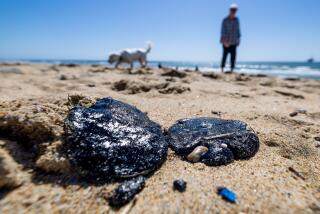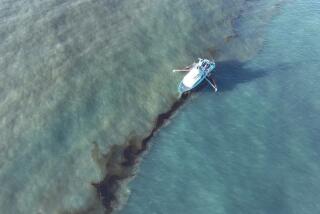Analysis: Gulf leak may be harsher type of oil
A first analysis of oil from the Gulf of Mexico spill suggests that it might not be typical Louisiana sweet crude, as was originally thought, but a heavier form of petroleum that could have a much harsher environmental impact and make cleanup much more difficult, one Louisiana oil spill expert warned Friday.
Most experts have assumed that the oil slick consists of Louisiana sweet crude because that is the predominant product in the region. The new analysis will make them take a closer look.
The analysis is based on only a single sample, “but it has caused my level of apprehension to go way up,” said environmental scientist Edward B. Overton of Louisiana State University, who is analyzing the oil for the National Oceanographic and Atmospheric Administration. So far, he appears to be the only researcher who thinks there may be a bigger-than-expected problem with the oil.
“This could be a fluke sample,” he conceded, and researchers are “desperately” trying to get more samples — a project that is not as simple as it might sound. “We’re hoping and praying that it is Louisiana sweet crude, but if it is not…this is going to be a very unique spill. We have never seen a spill with this high an asphaltenic content.”
Asphaltenes are the heaviest components of some crudes. They don’t burn, they are not attacked by bacteria in the environment, and they don’t evaporate. Their resistance to such degradation is what makes them useful in constructing roads that can survive weathering for long periods. But it also makes cleanup exceptionally difficult.
Asphaltenes are “a fairly sticky and gooey material that can be bad news for larger animals,” said earth scientist David Valentine of UC Santa Barbara. “Asphaltene oils seem to aggregate and don’t form slicks like light crude,” he said. The oil seepage off the coast of California is a good example of high-asphaltene-content oils, and its behavior — condensing into little balls when it rises to the surface of the ocean — is typical of such materials.
The gulf slick, “from what I have seen, seems consistent with it being a light crude oil,” he added. But he has not analyzed samples, and apparently no one besides Overton has either. Or at least, Overton said, no one seems to have examined the oil’s asphaltene content.
Light crude such as the Louisiana sweet crude is prized by refiners because it produces a greater proportion of gasoline and similar chemicals. Most of the oil in international commerce is light crude, and most previous large spills, such as the 1989 wreck of the Exxon Valdez off the coast of Alaska, have involved relatively light oils, Overton said.
Asphaltenes are less toxic than light crude, but they are much less biodegradable and much harder to wash off animals, birds and shorelines. They are resistant to the dispersants used to break oil into tiny particles that are more readily degraded in the environment. They are emulsified by seawater to form a viscous, gelatinous substance that is difficult to handle.
In other words, cleanup can be a nightmare. The federal government has been funding some research projects over the last five years to examine what happens to such oils in the environment, Valentine said, “but it is not well established what is going to happen to the stuff.”
The sample analyzed by Overton was collected by a skimmer that was sent out to collect oil from the ocean surface. “My only caveat is I don’t know the history of the skimmer. Was it empty when it went out,” or might it have already had some high-asphaltene material on board? “It’s not supposed to, but things like this happen in a spill,” Overton said.
“Everyone’s response is, ‘Let’s get some more samples,’” he said, “but the logistics are difficult. The spill is 50 miles out, which doesn’t sound like much, but in a motorcraft, that’s six to seven hours out and the same to get back. There’s no way to land a plane out there. It is way too rough.”
Overton hoped to have more samples analyzed by Sunday. Until then, all he could suggest was, “Stay tuned.”
More to Read
Sign up for Essential California
The most important California stories and recommendations in your inbox every morning.
You may occasionally receive promotional content from the Los Angeles Times.










